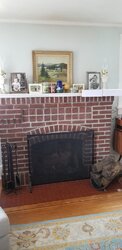I have an arched brick fireplace that we'd like to put a wood burning stove in so that it could provide some heat. Currently we don't light the fireplace in the winter and we would like to.
The challenge is, the arch is only 27 inches high in the middle, and 25.5 inches high where a wood burner would need to clear it. Currently, we like the Jøtul F 100 Nordic QT, but I think we would prefer one with an ash pan (though if they're as great as I've read on here I could be swayed). That lead us to the Vermont Castings Intrepid Flexburn, however I haven't heard great things about the company lately and would be hesitant to spend so much on something that wasn't a worry free sure thing.
We're not looking for it to be a primary source of heat, however we'd like it to be efficient (1400 two story house) and provide some heat.
Any recommendations would be greatly appreciated! We're definitely limited in the size burner we can have which makes the search difficult.
Thank you!!
The challenge is, the arch is only 27 inches high in the middle, and 25.5 inches high where a wood burner would need to clear it. Currently, we like the Jøtul F 100 Nordic QT, but I think we would prefer one with an ash pan (though if they're as great as I've read on here I could be swayed). That lead us to the Vermont Castings Intrepid Flexburn, however I haven't heard great things about the company lately and would be hesitant to spend so much on something that wasn't a worry free sure thing.
We're not looking for it to be a primary source of heat, however we'd like it to be efficient (1400 two story house) and provide some heat.
Any recommendations would be greatly appreciated! We're definitely limited in the size burner we can have which makes the search difficult.
Thank you!!



 And it's tougher if you can't see the stove in person...pretty much a shot in the dark at that point.
And it's tougher if you can't see the stove in person...pretty much a shot in the dark at that point.
